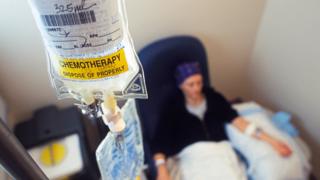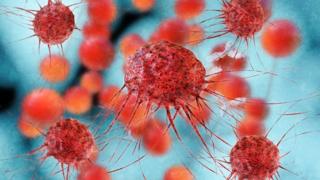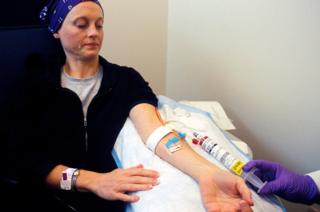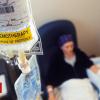 Image copyright Science Photo Library
Image copyright Science Photo Library
Chemotherapy is drug treatment which is used to try and kill cancer cells or stop them from spreading.
It is not the same treatment for every cancer – different cancer cells respond to different drugs.
Sometimes as many as eight different drugs are used in combination to get the best effect, and doctors are constantly trying out new combinations to improve treatment.
Chemotherapy is often associated with debilitating side effects, but many types of modern chemotherapy cause only mild problems.
Fewer women will need chemotherapy Breast cancer screening ‘more harm than good’ Warning over late effects of chemo on young
When is chemotherapy used?
Because chemotherapy drugs are usually injected into the blood, they travel around the body and can attack cancer cells regardless of where they find them.
 Image copyright Science Photo Library
Image copyright Science Photo Library
Radiotherapy, which uses radiation to destroy cancer cells, can only be given to small areas of the body or it will cause damage to too many healthy cells.
Often, after an operation to remove cancer, chemotherapy will be given to “mop up” any remaining cells.
Some cancers, such as leukaemia, need chemotherapy because they involve cells which are found throughout the body.
Chemotherapy can be given to shrink a tumour to make it easier for the surgeon to remove.
It can also ease the symptoms of patients whose cancer is not curable.
How does chemotherapy work?
Chemotherapy, in its traditional sense, is a chemical which is poisonous to cancer cells and kills them.
This is called a cytotoxic chemical – one very early chemotherapy was produced from mustard gas, which was used as chemical weaponry during World War One.
However anything which is poisonous to cancer cells may also be poisonous to the body’s healthy cells, which it needs to survive.
The trick with chemotherapy is to find a chemical which kills as many cancer cells as possible, and as few healthy cells.
 Image copyright Getty Images
Image copyright Getty Images
Doctors have been getting increasingly successful at developing such chemicals by spotting and exploiting the differences between the cancer cells and neighbouring normal cells.
The principle difference between many cancer cells and normal cells is the speed at which they reproduce, or divide.
Cancers tend to be dividing and growing faster than other cells in the body – which is why lumps or tumours sometimes appear.
Other cancer cells may become more or less active in response to natural chemicals called hormones produced by the body.
Some chemotherapy harnesses this reaction to control the growth of the cancer cells.
Cancer cells are not attacked by the body’s own immune defence system because the immune system does not recognise them as foreign.
Some chemotherapies try to programme the immune system to see the cancer cells as foreign so they can be attacked and destroyed.
How is chemotherapy given?
Normally chemotherapy is delivered by injection into a blood vein.
In many cases, a saline drip will be set up to dilute the drug as it enters the body. This stops it harming the vein because it is so concentrated.
If the patient needs frequent doses of different drugs, to avoid the discomfort of having to have separate injections every time, a tube is kept in the vein which attaches to the syringe. This is called a Hickman line when placed into a vein in the chest.
 Image copyright Science Photo Library
Image copyright Science Photo Library
Sometimes, a concentrated dose of chemotherapy is needed in a particular part of the body, and side effects can be lessened by injecting it directly into the cancerous area.
For example, for some bladder cancers, the drug can be pumped into the bladder so it works directly on the tissue involved.
How long chemotherapy courses last varies between different cancer types, with some being given intensively over a fortnight, normally in hospital, and some over a period of months.
What side-effects can be expected?
Because some chemotherapy targets fast-growing or fast-dividing cells, it is more likely to harm similar cells in the body.
These include the cells in the hair follicles, which is why cancer treatment is often associated with hair loss, although hair does re-grow once treatment has ended.
Other fast-dividing cells can be found in the stomach and bowel lining, which leads to nausea and diarrhoea.
There are, however, drugs which help to control this, and timing meals to avoid having a full stomach when the drugs take effect can also help in some cases.
 Image copyright Science Photo Library
Image copyright Science Photo Library
Other types of normal cell that can suffer are the blood cells.
Red cells are important to carry oxygen to keep other cells alive. Other blood cells help to stave off infection.
As a result, chemotherapy patients may be more prone to infections and find them harder to fight off.
Hospitals will take regular blood tests to monitor the levels of different cells. This is called a full blood count.
Generally, patients on chemotherapy can expected to have less energy than usual, or even feel extreme fatigue.
Chemotherapy can also affect the fertility of both men and women, and both can now freeze their sperm and eggs with the hope of using them to produce a test-tube baby.






